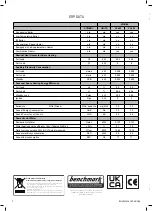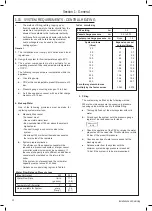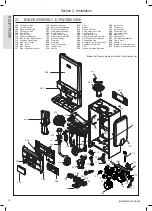
The boiler does not normally need a bypass but at least some
radiators on the heating circuit, of load of at least 10% of the
minimum boiler output, must be provided with twin lockshield
valves so that this minimum heating load is always available.
Note.
Systems incorporating zone valves which could completely
cut off the flow through the system must also include a bypass.
Balancing
1. Set the programmer to ON.
1.18 WATER TREATMENT
1.17 SYSTEM BALANCING
Central Heating
The Keston Combi
2
range of boilers have an ALUMINIUM
alloy heat exchanger.
IMPORTANT
The application of any other treatment
to this product may render the guarantee of Keston invalid.
The Keston System Filter will aid against the build up of iron
oxide debris, however the below water treatment is also
recommended by
Keston
.
Keston
recommend Water Treatment in accordance with the
Benchmark Guidance Notes on Water Treatment in Central
Heating Systems.
If water treatment is used,
Keston Heating
recommend
only the use of
SCALEMASTER SM-1 PRO, FERNOX MBI,
ADEY MC1, SENTINEL X100 or CALMAG CM100
inhibitors and
associated water treatment products, which must be used in
accordance with the manufacturers’ instructions.
1.16 SYSTEM REQUIREMENTS - DHW
Domestic Hot Water
1.
The DHW service must be in accordance with BS.5546 &
BS6700.
2.
Refer to Table 1 for minimum and maximum working
pressures. In areas of low mains water pressures the
domestic hot water regulator may be removed from the
DHW flow turbine cartridge. The boiler will require the flow
rate to be set to obtain a temperature rise of 35
o
C at the
tap furthest from the boiler.
Refer to Section
3.20
3.
The boilers are suitable for connection to most types of
washing machine and dishwasher appliances.
4.
If the shower/mixer valve does not incorporate non-return
valves the following must be followed:
a.
The cold inlet to the boiler is fitted with an approved
anti-vacuum or syphon non-return valve.
1.
It is most important that the correct concentration of the
water treatment products is maintained in accordance
with the manufacturers’ instructions.
2.
If the boiler is installed in an existing system any
unsuitable additives MUST be removed by thorough
cleansing. BS7593:2019 details the steps necessary to
clean a domestic heating system.
3.
In hard water areas, treatment to prevent lime scale may
be necessary - however the use of artificially softened
water is NOT permitted.
4.
Under no circumstances should the boiler be fired before
the system has been thoroughly flushed.
For further information contact:
Fernox
www.fernox.com Tel: +44 (0) 3301 007750
Sentinel Performance Solutions
www.sentinelprotects.com Tel: +44 (0) 1928 704330
Scalemaster Water Treatment Products
www.scalemaster.co.uk Tel: +44 (0) 1785 811636
Calmag Ltd
.
www.calmag Ltd.com Tel: +44 (0) 1535 210320
Adey
www.adey.com Tel: +44 (0) 1242 546700
b.
Hot and cold water supplies to the shower are of
equal pressure.
5. Hard Water Areas
Where the water hardness exceeds 200 mg/litre (200 ppm),
it is recommended that a proprietary scale reducing device
is fitted into the boiler cold supply within the requirements of
the local water company.
IMPORTANT
Provision must be made to
accommodate the expansion of DHW contained within the
appliance. If the DHW inlet contains a back flow prevention
device or non-return valve, e.g. a water meter, then a mini
expansion vessel should be fitted between the device and
the boiler in the cold inlet pipe.
Cold water, rising main and pipework in exposed areas
need to be suitably lagged to prevent freezing.
Note
DHW Expansion Vessel kit available from Keston.
2. Close the manual or thermostatic valves on all radiators,
leaving the twin lockshield valves (on the radiators
referred to above) in the OPEN position.
3. Turn up the room thermostat and adjust the lockshield
valve to give an uninterrupted flow through the radiator.
These valves should now be left as set.
4. Open all manual or thermostatic radiator valves and
adjust the lockshield valves on the remaining radiators,
to give around 20
o
C temperature drop at each radiator.
5. Adjust the room thermostat and programmer to
NORMAL settings.
CAUTION:
Do not fill the heating system with softened
water. Softened water could enhance corrosion.
Refer to Section
1.11
13
Installation and Servicing
Section 1 - General














































